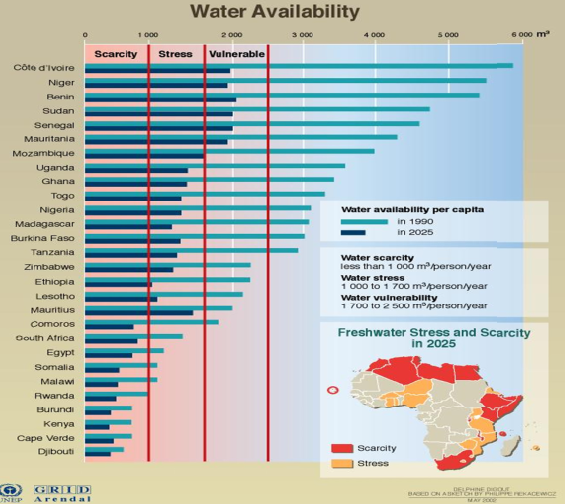
The Water sector is predicted to be the main channel through which climate change impacts will be felt by people, ecosystems, and the economy in Uganda. Both observational records and climate projections provide strong evidence that water resources are vulnerable, with the potential for significant impacts. However, predicting the effects on the availability and quality of freshwater resources, especially on urban water utilities and water-dependent services, remains a daunting task.
Despite the uncertainty, there is a growing body of evidence documenting the potential changes in water systems expected in a changing climate. Notably, the effects of climate change can be grouped into three categories, thus: Increasing Intensity of Rainfall, Greater Rainfall Variability, and Longer-Term Decline in Rainfall and Runoff.
In areas where average rainfall is expected to decrease, a greater proportion of rainfall is likely to occur in heavy rainfall events. This leads to an increased risk of flooding, resulting in infrastructure damage and contamination of surface and groundwater supplies. Recent flooding in areas like Kyoga, Victoria, and the R. Nile catchment areas underscores these risks. Piped water systems are particularly vulnerable due to their size and complexity, exposing them to multiple threats from source to delivery. Furthermore, increased runoff from fertilizers, animal waste, and particulates into water supplies can affect both water quality and flow.
Changes in the timing, duration, and distribution of rainfall across the country are expected. This could result in longer and more frequent droughts, impacting water supply systems relying on seasonal sources such as swamps and dams. Urban systems dependent on limited and variable surface water flows, as well as groundwater-based supplies like springs and shallow wells, could face challenges in buffering seasonal and inter-annual variability.
Declining annual rainfall, coupled with population growth and increased agricultural demands, could lead to reductions in river flows. This, in turn, might increase the demand for groundwater, potentially posing sustainability risks.
Despite the potential risks, hazards, and challenges associated with climate change, it does not appear to be among the highest priority concerns for NWSC (National Water and Sewerage Corporation).
Therefore, there is an urgent need for adaptation and resilience-building through Climate Risk Management. This approach involves systematically examining activities, projects, programs, policies, and technologies with the aim of:
Identifying hazards that could potentially cause harm. Recognizing inherent vulnerabilities in the system. Assessing whether these risks, which are the product of hazard and vulnerability, are adequately considered. Considering ways to reduce or mitigate risks.
Since the probability of the hazard occurring cannot be reduced, the emphasis lies in exploring opportunities to reduce vulnerability associated with physical hazards. A risk management approach prioritizes preventative measures over reactive ones. While complete risk elimination is seldom possible, the focus should be on identifying the most significant risks and prioritizing their mitigation.
Simply put, NWSC must proactively address the challenges posed by climate change to ensure a reliable and sustainable water supply for Uganda’s growing population. Building resilience through climate risk management is not just a necessity but a responsibility in safeguarding the nation’s water resources and securing its future.


